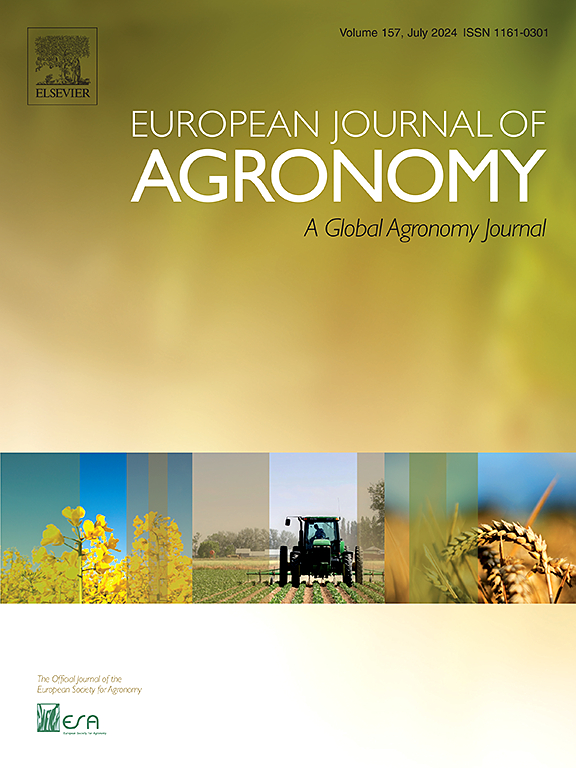The efficacy of 1-aminocyclopropane-1-carboxylic acid (ACC) in thinning apples under Chilean conditions
IF 4.5
1区 农林科学
Q1 AGRONOMY
引用次数: 0
Abstract
In Chile, apple trees commonly show high fruit set: ∼2.0–2.5 fruits/cluster; therefore, strong chemical thinning strategies are needed to avoid or reduce hand thinning. 1-aminocyclopropane-1-carboxylic acid (ACC; Accede®), an ethylene precursor, has been registered as flower or fruitlet thinner for different fruit crops, but it must be validated according to species, cultivars and weather conditions. The aim of this study was (i) to evaluate the efficacy of ACC concentrations since bloom up to the timing of ‘rescue’ treatments, later in the season, and (ii) to evaluate it as part of commercial chemical thinning programs (CCTP). Six trials in ‘Brookfield Gala’’ and 5 in ‘Fuji Raku Raku’ were done during four seasons. Across the seasons and cultivars, ACC, alone or as part of a CCTP, reduced fruit set in a dose-moment-cultivar dependent manner. For 'Gala', ACC at full bloom (224 and 448 mg L−1) was highly effective in thinning flowers, equivalent to the effect of 12 mg L−1 of NAA. From petal fall up to fruits of 10–12 mm in diameter, 448 mg L−1 reduced fruit set; higher concentration (672 mg L−1) was required when fruits reached between 18 and 25 mm. At the same period 672 mg L−1 or higher concentrations with a coadjuvant or oil showed slight to moderate leaf drop, depending on the season. The thinner efficacy of 400 mg L−1 of ethephon was similar to all ACC concentrations (448–672 mg L−1) at 25 mm; however, it showed lower fruit weight and yield than ACC treatments. For 'Fuji', higher ACC concentration was required; 672 mg L−1 at full bloom reduced fruit set from 2.5 to 1.5 fruits/cluster, which is considered good effect for 'Fuji'. Between fruits of 4 mm up to fruits of 10–12 mm in diameter and under good weather conditions for thinning (i.e., projected less carbohydrate availability), 448–672 mg L−1 reduced fruit set, but not under “bad” conditions for thinning (i.e., cold nights and hot sunny days). Similar results were observed for "rescue" treatments, when only 896 mg L−1 reduced fruit set until targeted fruit set (0.8–1.0 fruits/cluster), while medium rates (448–672 mg L−1) plus coadjuvant generated a moderate thinning effect, but only under favorable weather conditions. In conclusion, ACC is a promising thinner for full bloom and also as a "rescue" thinner for apples, particularly at the 18–25 mm stage when other thinners are ineffective.
求助全文
约1分钟内获得全文
求助全文
来源期刊

European Journal of Agronomy
农林科学-农艺学
CiteScore
8.30
自引率
7.70%
发文量
187
审稿时长
4.5 months
期刊介绍:
The European Journal of Agronomy, the official journal of the European Society for Agronomy, publishes original research papers reporting experimental and theoretical contributions to field-based agronomy and crop science. The journal will consider research at the field level for agricultural, horticultural and tree crops, that uses comprehensive and explanatory approaches. The EJA covers the following topics:
crop physiology
crop production and management including irrigation, fertilization and soil management
agroclimatology and modelling
plant-soil relationships
crop quality and post-harvest physiology
farming and cropping systems
agroecosystems and the environment
crop-weed interactions and management
organic farming
horticultural crops
papers from the European Society for Agronomy bi-annual meetings
In determining the suitability of submitted articles for publication, particular scrutiny is placed on the degree of novelty and significance of the research and the extent to which it adds to existing knowledge in agronomy.
 求助内容:
求助内容: 应助结果提醒方式:
应助结果提醒方式:


